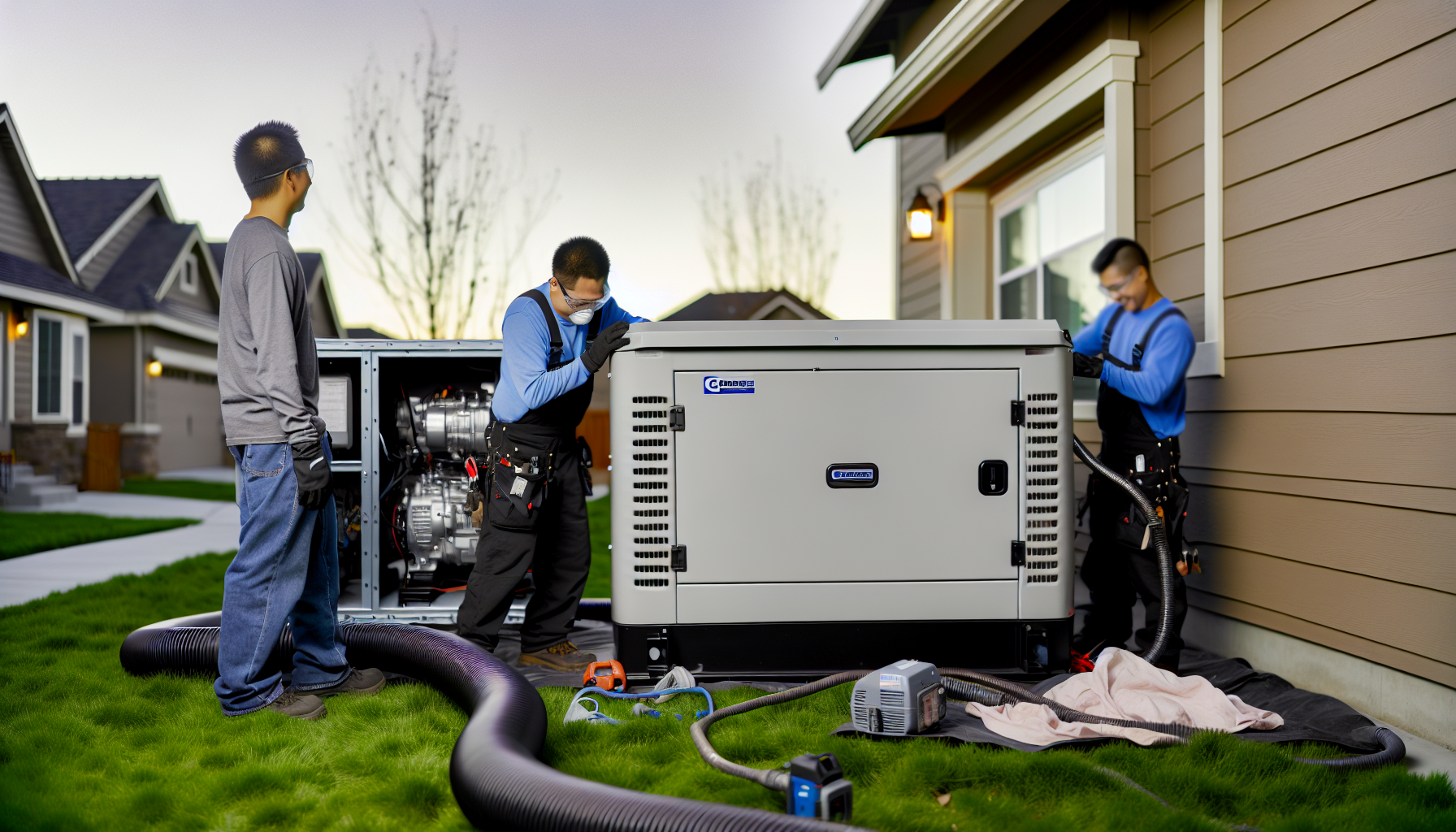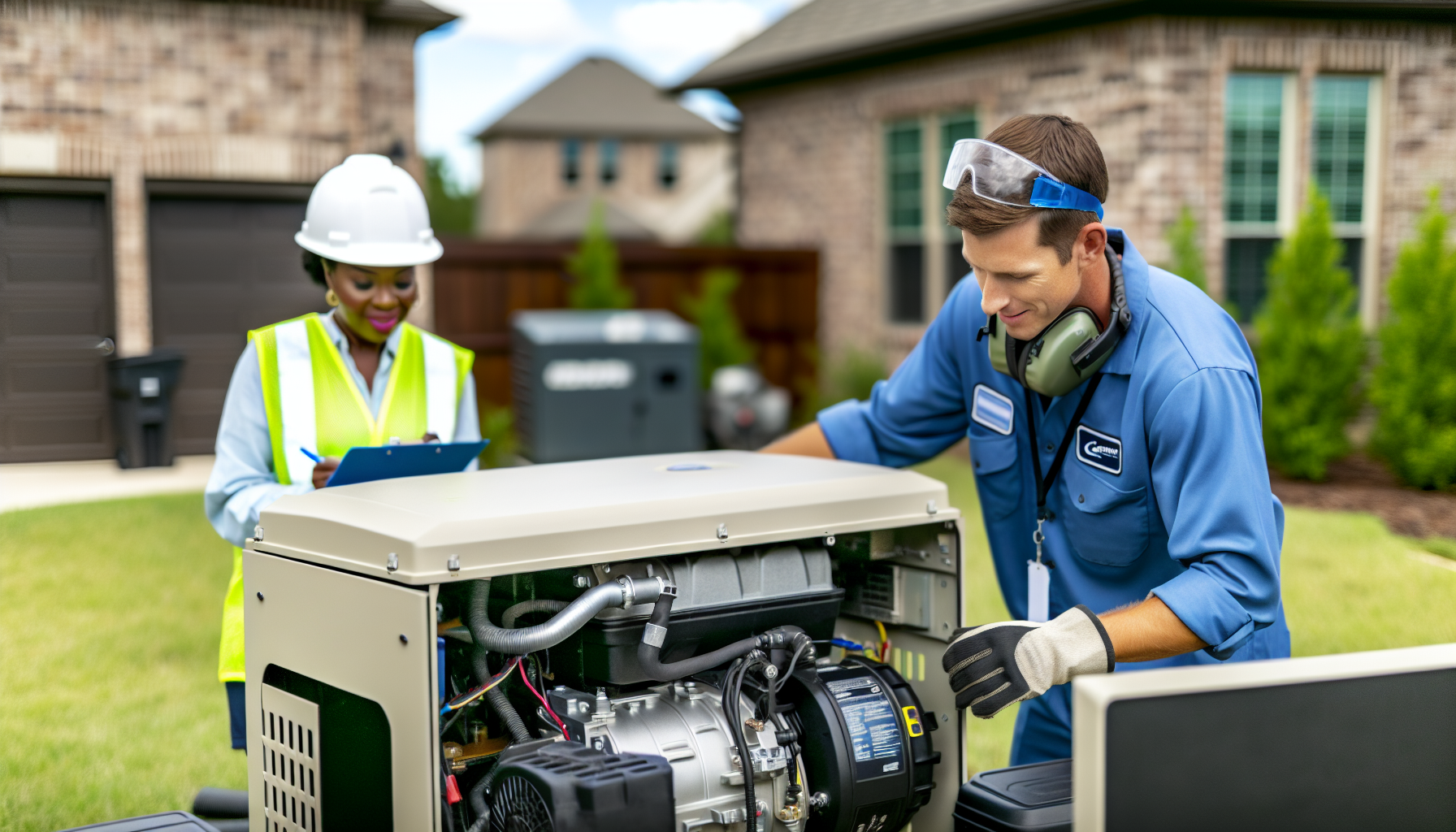Choosing the Right Fit: How Big of a Standby Generator Do I Need for Reliable Home Power?
Determining ‘how big of a standby generator do I need’ can seem challenging, but it’s crucial for reliable home power. The right generator size depends on your essential appliances and overall power use. This guide will help you calculate the wattage you need, consider surge power demands, and choose the right generator that ensures your comfort during a power outage without going beyond what’s necessary.
Contents
- 1 Key Takeaways
- 2 Understand Your Home’s Power Profile
- 3 Sample Calculation For The Right Size Generator
- 4 Decode Standby Generator Sizes
- 5 The Role of Transfer Switches in Generator Sizing
- 6 Installation Considerations for Home Standby Generators
- 7 Fuel Options and Their Impact on Generator Size
- 8 Real-Life Examples: Sizing Generators for Different Homes
- 9 Prepare for Extreme Conditions
- 10 Balance Cost and Capacity
- 11 Maintenance Matters: Keep Your Generator Ready
- 12 Conclusion
- 13 Frequently Asked Questions (FAQs):
- 13.1 How big of a standby generator do I need for a 2000 sq ft house?
- 13.2 How big of a house will a 22kw generator run?
- 13.3 How do you calculate the size of a standby generator?
- 13.4 What is the role of a transfer switch in a generator?
- 13.5 How does the fuel option affect the size and performance of a generator?
Key Takeaways
- You have to know your power needs: Identify essential appliances and calculate their total wattage, also include the surge power of the devices.
- Choose the right generator type: Is a small portable generator enough for basic needs or do you need a whole house generator for complete coverage during power outages?
- Don’t forget the extras: Make sure that you have a properly sized transfer switch and regularly maintain your generator to keep it running smoothly and efficiently.
Understand Your Home’s Power Profile
Have you ever thought about how much power your home uses? Your home’s power profile is like a snapshot of all the electricity it consumes, highlighting which appliances and devices use the most. This information is really important when you’re choosing the right size of standby generator for your home because the generator should handle all your power needs.
Identify Essential Appliances
So, what counts as essential household appliances? The answer can vary from one household to another. For some, it’s about keeping the lights on and the refrigerator running. For others, it could be about ensuring the smooth operation of medical equipment. But for most of us, it’s a mix of appliances and devices that make our lives comfortable and convenient. Some examples of essential appliances include:
- Refrigerator
- Stove or oven
- Washing machine
- Dishwasher
- Microwave
- Air conditioner
- Heater
- Television
- Computer or laptop
- Smartphone
These are just a few examples, and the specific appliances that are considered essential can also vary. It all depends on individual needs and preferences.

Bear in mind, that appliance power consumption can vary significantly. For instance, a refrigerator uses between 300 to 800 watts, while an electric furnace can require up to 18,000 watts. The key is to identify the devices and appliances that you absolutely cannot do without during a power outage and write down their power consumption.
Evaluate Your Total Wattage Needs
Once you’ve identified your essential appliances, the next step is to calculate your total wattage needs. Just add up the power consumption (wattage) of all these appliances. The total represents your home’s power profile.
Remember, power consumption isn’t a fixed figure. It changes based on appliance usage frequency and duration. For instance, a 1500-watt toaster oven that you use for an hour every day will consume more power in a month than a 2000-watt air conditioner that you only use for 15 minutes a day. So, it’s essential to consider how much electricity each appliance consumes to make informed decisions about energy usage.
An electricity usage monitor can be very useful in tracking this usage and enables you a more accurate calculation of your total wattage needs.
If you need an electricity usage monitor, I’ll link you to one that I use myself.
Consider Surge Power Demands (Starting Watts)
In addition to the steady state power consumption of your appliances or devices, it’s also important to consider their surge power demands. These are momentary spikes in power that occur when an appliance is turned on. For instance, a refrigerator may require about 780 watts of extra power at startup.
Ignoring surge power demands can be a costly mistake. If your generator cannot handle these power spikes, it can affect its performance and also damage your appliances. So when you determine your generator’s size, you have to consider both the steady state and surge power requirements of your home.
Sample Calculation For The Right Size Generator
Let’s consider an example to calculate the power needs of a generator for a typical household during a power outage.
Essential Appliances
- Refrigerator (800 watts)
- Lights (200 watts)
- TV (150 watts)
- Microwave (1000 watts)
- Laptop (50 watts)
- Total: 2100 watts
Starting Watts
- The refrigerator requires more power to start up than to run continuously (running watts). For instance, a refrigerator might need around 2000 watts to start but only 800 watts to run.
- For LED light bulbs, there isn’t a significant surge in power when they are turned on.
- A TV doesn’t have high starting watts. Of course, it depends on the model whether it is a LCD, LED, or Plasma. Starting watts would be around 150.
- Like the fridge, a microwave also consumes a lot of power to start. We assume a medium-sized microwave in this article and calculate with 1000 starting watts.
- Generally, laptops consume relatively low power compared to other household appliances. Therefore, for practical purposes, you can consider the running watts of a laptop when calculating the power needs for a generator.
Calculate Total Starting and Running Watts:
- Refrigerator: 2000 watts (starting) + 800 watts (running) = 2800 watts
- Lights: 200 watts
- TV: 150 watts (starting) +150 watts (running) = 300 watts
- Microwave: 1000 watts (starting) + 1000 watts (running) = 2000 watts
- Laptop: 50 watts
- Total Starting Watts: 2800 watts + 200 watts + 300 watts + 2000 watts + 50 watts = 5350 watts
Select a Generator
Based on the total starting watts (5350 watts) needed to power all essential appliances simultaneously, you’d want a generator with a minimum rating of 5350 watts or higher to make sure it can handle the initial power surge and continuous operation.
Consider Extra Capacity
It’s also wise to choose a generator with slightly more capacity than your calculated needs to accommodate additional appliances or unexpected power demands.
Decode Standby Generator Sizes
Once you know exactly how much power your home uses, you can start figuring out which size standby generator is best for you. Think of it like finding a tailored suit – the perfect generator should match your home’s power requirements perfectly.
Small Generators: When Less Is Enough
Small generators, despite their compact size, pack quite a punch. With power outputs ranging from 800 watts to over 5000 watts, they’re capable of keeping essential appliances running smoothly during a power outage. The portability is an important point because you can use the generator for backup power but also for outdoor activities for example camping. If you want to be prepared for unexpected situations it will be a smart move to invest in a portable generator.
However, it’s important to note that a small generator might not be sufficient for larger homes or homes with high power demands. If you rely on a small generator for backup power, make sure it has enough capacity to handle your essential appliances during an outage. Otherwise, it might not be powerful enough to meet your needs.
Whole House Generators: Ensuring Complete Coverage

In contrast to small generators, whole house generators are made to power, well, your whole house. They can power all the appliances and devices in your home.
Whole house generators can supply anywhere from 2kW to 20kW, depending on their capacity. If your entire home has a high power consumption and you live in an area prone to long power outages, then we recommend a whole-house generator. Such generators kick in when a power outage occurs, and the devices and appliances in your house continue to run smoothly.
The Role of Transfer Switches in Generator Sizing
While our focus has been on generators, we shouldn’t neglect an important component ensuring their smooth operation – the transfer switch. This device connects the generator to your home’s electrical panel and seamlessly switches the power source from the utility to the generator during a power outage.
The transfer switch size should correspond with the generator size.
This is because the transfer switch controls how much power can flow from the generator to your home. A mismatch can lead to underutilization of the generator’s capacity or, worse, overload and potential damage.
Installation Considerations for Home Standby Generators

Now that you’ve chosen the perfect generator for you, it’s time to bring it home and install it. This is a critical step, and we highly recommend getting professional help here. Wrong installation can result in inefficiencies, and safety hazards, and even impact your generator’s sizing.
In addition to the technical aspects of the installation, the placement of the generator is also important. It should be easily accessible for maintenance, protected from the weather, and far enough away from your living area to minimize noise and exhaust fumes. Remember: a well-installed generator is a well-performing generator!
If you are interested in How To Install A Backup Generator – read our guide!
Fuel Options and Their Impact on Generator Size
If you want to power your generator, you have several fuel options – diesel, propane, or natural gas. Each has its pros and cons, and the choice can affect the performance of your generator.
While diesel generators are known for their efficiency, they are also typically larger. Propane generators, on the other hand, can offer efficient power but may not be suitable for homes with high power consumption. It’s crucial to consider these factors when selecting your generator’s fuel type.
Real-Life Examples: Sizing Generators for Different Homes
To put all this into perspective, let’s look at some real-life examples. For a medium-sized home, a generator providing between 5,000 and 8,000 watts is typically sufficient. On the other hand, a large home may require a generator with a capacity of 7,500 watts or more.
Remember, these are just examples. The power requirements of your home may differ based on the number of appliances in use, their power consumption, and the regularity and length of power outages in your area. The key is to understand your home’s power profile and choose a generator that fits it just right!
Prepare for Extreme Conditions
Choosing a generator isn’t just about your everyday power needs. Also, the preparation for extreme conditions is essential. It can come to extended power outages that can be caused by harsh weather and can exert stress on your generator. In such cases, a larger generator with a high power output can be beneficial.
You have to remember, that a backup generator is an investment in your home’s safety and comfort. Make sure it’s ready to handle whatever Mother Nature throws at it.
Balance Cost and Capacity
Let’s face it – cost matters a lot when you’re picking out a generator. The price you pay depends on how big and powerful the generator is. Those whole-house generators that cover everything? They’re great but can be pretty expensive.
The trick is finding a balance between what you need and what you can afford.
Figure out how much power you need, set a budget, and find a generator that gives you the maximum value for the money. Remember, it’s not just about getting the biggest or cheapest generator – it’s about getting one that gets the job done without breaking the bank.
Maintenance Matters: Keep Your Generator Ready
Choosing and installing the right generator is just the beginning. You’ve got to keep up with regular maintenance to make sure your generator keeps working well and lasts a long time. This means doing things like checking it regularly, changing the oil when needed, and giving it thorough inspections.
Taking care of your generator isn’t just about being ready for power outages; it’s also about catching any problems early before they become expensive fixes.
Remember, a generator that’s well taken care of is a generator you can rely on!
Conclusion
To sum up, picking the perfect standby generator for your home involves a few important steps. First off, you need to know how much power your home uses. Then, you’ll look at the various generator sizes and types, think about how they’ll fit in your space, and consider what kind of fuel they need. It’s also smart to get ready for any tough weather conditions.
Don’t forget about regular maintenance – it’s what keeps your generator in top shape for when you need it most. By understanding all these things, you can find a generator that matches your needs and wallet, ensuring you have power when you need it and peace of mind during outages.
Frequently Asked Questions (FAQs):
How big of a standby generator do I need for a 2000 sq ft house?
You will need a standby generator with a capacity between 8.5 kW and 10 kW for a 2000-square-foot house to effectively meet your electricity needs during power outages.
How big of a house will a 22kw generator run?
A 22kw generator will power a 3-4,000 square foot house, running the HVAC equipment and appliances simultaneously. It’s important to prioritize and select which appliances to use to ensure efficient use of propane.
How do you calculate the size of a standby generator?
To calculate the size of a standby generator for your home, add up the total watts your home is likely to use during an outage and divide the total watts by 1000 to find kilowatts. Then, add a 20% safety margin. This final number is your minimum Generator Capacity requirement for your home.
What is the role of a transfer switch in a generator?
The transfer switch connects the generator to your home’s electrical panel, allowing it to switch the power source from the utility to the generator during a power outage. Make sure the size of the transfer switch matches the size of the generator.
How does the fuel option affect the size and performance of a generator?
The fuel option of a generator can affect both its size and performance. Diesel generators are known for efficiency but are typically larger, while propane generators provide efficient power but may not be suitable for high-power consumption homes.


